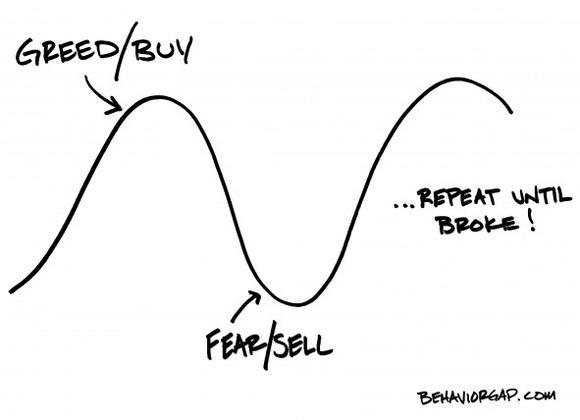
The Dow Jones Industrials (^DJI +0.55%) managed to regain all of yesterday's lost ground and then some, finishing up more than 65 points, and clawing to within reach of a new all-time closing record. Even though the Dow hasn't put together the huge gains this year that it did in 2013, it has nevertheless held up well even through challenges like a tough winter economy. Yet now, rising levels of investor confidence suggest that complacency might well be at dangerous levels, as the S&P Volatility Index (^VIX +0.46%) remains at extremely low levels, and the iPath S&P 500 VIX Short-Term Futures ETN (VXX +0.00%) hits yet another all-time record low. Are investors being greedy when they should be fearful?

Source: Carl Richards, BehaviorGap.com.
Looking at confidence
The latest survey results from the American Association of Individual Investors showed a huge surge of bullish sentiment following the ascent of the stock market during the past week. In just a single week, the number of bullish investors rose six percentage points, to 36.5%, while bearish investor counts fell by more than three percentage points. Although the number of neutral investors remains well above typical levels, the number of bears is almost a full quarter below the long-term historical average.
At first glance, the proportion of bullish investors might seem like a good reason to feel confident about the market. But sentiment indicators often run contrary to the actual direction of the market. For instance, in 2009 at the market's lows, investor sentiment was terrible. It took the ensuing recovery from those low levels to bring about gains in sentiment, and even years later, many investors still haven't invested in the Dow Jones Industrials or other stocks because of their fears of another market meltdown.
Meanwhile, the S&P Volatility Index has slipped to its lowest levels in years, falling nearly to 11 for the first time since 2007. Specifically, what the Volatility Index measures is the price that investors are willing to pay for protection from market movements using options strategies, and the lack of fear of a sizable correction appears to be driving the VIX lower and taking volatility-tracking products like iPath S&P 500 VIX ST Futures ETN down with it.
All told, the level of complacency on Wall Street is so high that it has to be troubling to contrarian investors. The problem, though, is that contrarians could have made the same case several times in recent years; yet the market has only pulled back slightly on all of those occasions. In the end, it appears that it will take a large and unforeseen catalyst to push the Dow Jones Industrials down into a full-fledged correction. Until that happens, greedy investors might well end up getting rewarded rather than punished.





